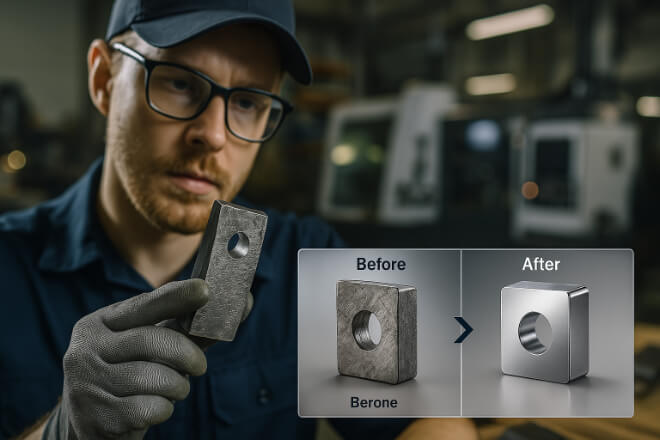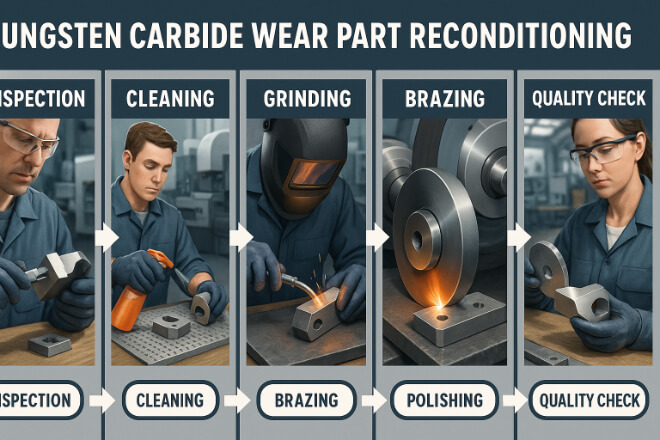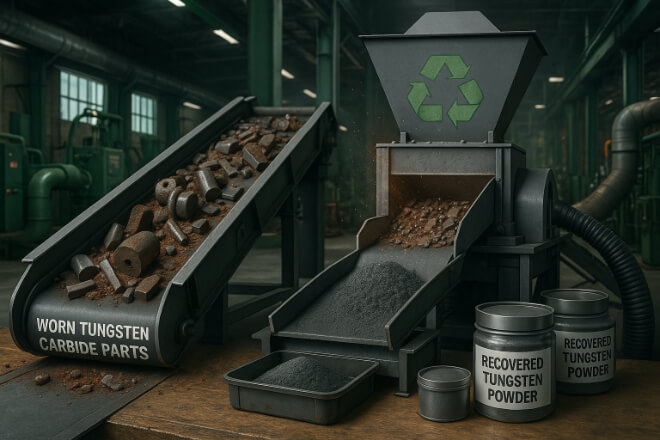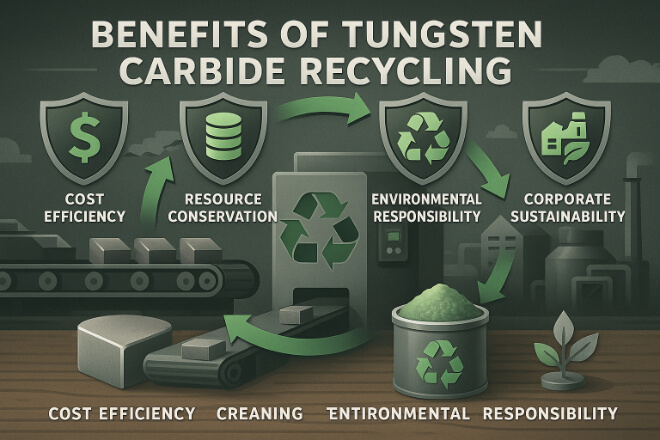Các bộ phận hao mòn cacbua vonfram được biết đến với sức mạnh của chúng, độ cứng, Và khả năng chống mài mòn. Chúng được sử dụng trong nhiều ngành công nghiệp, chẳng hạn như khai thác mỏ, dầu khí, sản xuất và chế biến gỗ.
Theo thời gian, ngay cả những chi tiết cacbua cứng cáp nhất cũng bị hao mòn. Thay vì thay thế chúng bằng các linh kiện hoàn toàn mới, các công ty có thể lựa chọn tân trang hoặc tái chế để tiết kiệm chi phí và bảo vệ môi trường.
Bài viết này giải thích cách thức tân trang và tái chế hoạt động, tầm quan trọng của chúng và những điều mà người ra quyết định trong ngành cần biết để tận dụng tối đa giá trị từ các bộ phận cacbua của họ.
Tại sao việc tân trang lại các bộ phận hao mòn cacbua lại quan trọng

Tân trang nghĩa là khôi phục các bộ phận đã qua sử dụng về hình dạng, kích thước và hiệu suất ban đầu. Thay vì loại bỏ các bộ phận bị mòn, các kỹ thuật viên lành nghề sẽ sửa chữa và làm mới bề mặt chúng.
Các lợi ích bao gồm:
Tiết kiệm chi phí – Việc tân trang có thể rẻ hơn 30–70% so với việc mua phụ tùng mới.
Kéo dài tuổi thọ – Các bộ phận được phục hồi đúng cách có thể sử dụng được lâu gần như các bộ phận mới.
Giảm thời gian chết – Thời gian xử lý nhanh hơn so với sản xuất các bộ phận mới.
Tính bền vững – Ít lãng phí vật liệu và tác động đến môi trường thấp hơn.
Quá trình tái tạo

Quy trình này thay đổi tùy thuộc vào loại chi tiết mài mòn cacbua, nhưng nhìn chung bao gồm:
Kiểm tra và Đánh giá – Bộ phận được kiểm tra xem có vết nứt, mẻ và hư hỏng về cấu trúc không.
Vệ sinh – Loại bỏ bụi bẩn, dầu mỡ và mảnh vụn.
Mài và định hình lại – Máy chuyên dụng khôi phục lại hình dạng và dung sai chính xác.
Hàn hoặc hàn điện (nếu cần) – Các phần bị hỏng sẽ được xây dựng lại bằng vật liệu cacbua tương thích.
Đánh bóng và phủ – Bề mặt được phủ một lớp mịn và có thể thêm lớp phủ bảo vệ.
Kiểm tra chất lượng cuối cùng – Kích thước và hiệu suất được xác minh trước khi đưa bộ phận trở lại sử dụng.
Khi nào nên chọn tân trang so với thay thế
| Tình trạng của một phần | Lựa chọn tốt nhất |
|---|---|
| Hao mòn nhỏ, không có vết nứt | Tái tạo |
| Độ mòn vừa phải, một số cạnh bị sứt mẻ | Tái tạo |
| Mòn nghiêm trọng, vết nứt sâu | Thay thế |
| Các phần bị hỏng hoặc bị thiếu | Thay thế |
Tái chế các bộ phận mài mòn cacbua vonfram

Tái chế khác với tân trang. Nó bao gồm việc phân hủy các bộ phận cacbua đã qua sử dụng thành nguyên liệu thô có thể được sử dụng để sản xuất sản phẩm mới.
Các bước tái chế bao gồm:
Thu thập – Các bộ phận cacbua đã qua sử dụng được thu thập từ nhiều địa điểm khác nhau.
Phân loại – Tách cacbua ra khỏi các kim loại hoặc vật liệu khác.
Xử lý – Nghiền, xay hoặc xử lý hóa học các bộ phận để thu hồi vonfram và coban.
Tinh chế – Loại bỏ tạp chất để thu được bột vonfram có độ tinh khiết cao.
Cải tạo – Cacbua vonfram thu hồi được sử dụng để sản xuất các bộ phận chịu mài mòn mới.
Ưu điểm của việc tái chế các bộ phận cacbua

Hiệu quả về chi phí – Vonfram tái chế rẻ hơn so với khai thác vonfram mới.
Bảo tồn tài nguyên – Vonfram là nguồn tài nguyên hữu hạn và việc tái chế sẽ làm giảm nhu cầu khai thác mới.
Trách nhiệm với môi trường – Giảm khai thác có nghĩa là giảm thiệt hại sinh thái.
Mục tiêu phát triển bền vững của doanh nghiệp – Giúp các công ty đạt được mục tiêu sản xuất xanh.
Các ngành công nghiệp được hưởng lợi nhiều nhất
| Ngành công nghiệp | Các bộ phận hao mòn cacbua thông thường | Tiềm năng tái tạo |
|---|---|---|
| Khai thác mỏ | Mũi khoan, đầu nghiền | Cao |
| Dầu khí | Ghế van, dụng cụ kiểm soát lưu lượng | Trung bình |
| Gia công kim loại | Chèn cắt, khuôn | Cao |
| Chế biến gỗ | Mũi cưa, lưỡi bào | Cao |
Người ra quyết định có thể tối đa hóa giá trị như thế nào

Đối với các nhà lãnh đạo ngành, việc quyết định giữa tân trang và tái chế phụ thuộc vào tình trạng linh kiện, chi phí và nhu cầu vận hành. Một phương pháp tối ưu bao gồm:
Thiết lập lịch kiểm tra để phát hiện sớm tình trạng hao mòn.
Hợp tác với các chuyên gia tân trang đáng tin cậy.
Thiết lập chương trình tái chế cacbua trong công ty.
Theo dõi chi phí tiết kiệm được từ việc tân trang so với thay thế.
Phần kết luận
Việc tân trang và tái chế các bộ phận hao mòn bằng cacbua giúp các công ty tiết kiệm tiền, giảm thiểu chất thải và kéo dài tuổi thọ của các nguồn tài nguyên có giá trị.
Những người ra quyết định áp dụng các biện pháp này có thể cải thiện hiệu quả, hỗ trợ tính bền vững và duy trì hiệu suất cao trong môi trường công nghiệp đầy thách thức.
Nếu bạn muốn biết thêm chi tiết về bất kỳ công ty nào, vui lòng liên hệ với chúng tôi.
